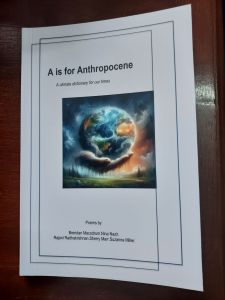Yesterday, I got my new chapbook, A is for Anthropocene: A climate dictionary for our times, printed.
One copy, just for myself, just to see what it would look like in its ultimate form. It is a violation though, for a collection of poems on the climate crisis. It should exist only in its digital avatar, actually there should be no climate crisis and it shouldn’t exist at all.
That said, there is great power in holding a book in your hands, the real book, your book, smelling of paper and ink and sweat and blood, pushing bookmarks through the pages, imagining yellow highlights and annotations and book shelves and dogears. Oh yes! While my fellow-poets in this collection live in different countries, and that meant so much as we pulled together our global perspectives, I wished for a moment that they all lived here, in my town, so I could ring their doorbells and hand them each a copy (yes, I shouldn’t print one, leave alone five, I know).
But all that apart, I write this today to celebrate digital chapbooks and little self-published collections. Stuff that doesn’t make it to Amazon or the corner bookstore. Stuff that has no Goodreads review or ISBN number. May they all reach many, many hands. May they all be passed from reader to reader. May they all rest, worn and creased and loved, along with precious others. May they be read. A little.
I have five collections that I never took to a mainstream publisher. Big ones, little ones, somewhat-in-the-middle ones. It was enough to just gather the poems, name the chapbooks and tell a few other poets, some of whom might have even read them. It didn’t matter. Not then. Perhaps, not even now. I have no idea why I do this, though I am quite sure I will do one more, maybe a few more. Why? For what? For whom? (P.S. for poetry or for the poet are not quite the right answers)
So, should they exist? Should there be a library of lost chapbooks? Should anyone care? Should they die like they were born, quietly, wearing their Adobe best, in the archive of a blog or a social media post? Or recycled for the planet’s sake? (There is a climate crisis, isn’t there?) Or should they be read in libraries and book stores, in schools and holiday gatherings, in book clubs and bars, gifted for Diwali or New Year? To whom? By whom?
It doesn’t matter, dear poet, dear reader, or does it?




